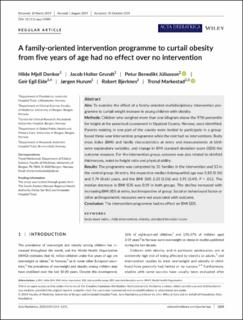| dc.contributor.author | Donkor, Hilde Mjell | |
| dc.contributor.author | Grundt, Jacob Holter | |
| dc.contributor.author | Juliusson, Petur Benedikt | |
| dc.contributor.author | Eide, Geir Egil | |
| dc.contributor.author | Hurum, Jørgen | |
| dc.contributor.author | Bjerknes, Robert | |
| dc.contributor.author | Markestad, Trond Jacob | |
| dc.date.accessioned | 2023-10-31T10:07:24Z | |
| dc.date.available | 2023-10-31T10:07:24Z | |
| dc.date.created | 2021-01-11T18:14:28Z | |
| dc.date.issued | 2020 | |
| dc.identifier.citation | Acta Paediatrica. 2020, 109 (6), 1243-1251. | en_US |
| dc.identifier.issn | 0803-5253 | |
| dc.identifier.uri | https://hdl.handle.net/11250/3099683 | |
| dc.description.abstract | Aim: To examine the effect of a family-oriented multidisciplinary intervention programme to curtail weight increase in young children with obesity. Methods: Children who weighed more than one kilogram above the 97th percentile for height at the preschool assessment in Oppland County, Norway, were identified. Parents residing in one part of the county were invited to participate in a group-based three-year intervention programme while the rest had no interventions. Body mass index (BMI) and family characteristics at entry and measurements at birth were explanatory variables, and change in BMI standard deviation score (SDS) the outcome measure. For the intervention group, outcome was also related to skinfold thicknesses, waist-to-height ratio and physical ability. Results: The programme was completed by 31 families in the intervention and 33 in the control group. At entry, the respective median (interquartile) age was 5.83 (0.36) and 5.74 (0.66) years, and the BMI SDS 2.35 (1.06) and 1.95 (0.49), P = .012. The median decrease in BMI SDS was 0.19 in both groups. The decline increased with increasing BMI SDS at entry, but irrespective of group. Social or behavioural factor or other anthropometric measures were not associated with outcome. Conclusion: The intervention programme had no effect on BMI SDS. Keywords: body mass index; child; intervention; obesity; standard deviation score. | en_US |
| dc.description.sponsorship | The study was funded through grants from The South-Eastern Norway Regional Health Authority (Helse Sør Øst) and Innlandet Hospital Trust. | en_US |
| dc.language.iso | eng | en_US |
| dc.publisher | Wiley | en_US |
| dc.relation.uri | https://onlinelibrary.wiley.com/doi/epdf/10.1111/apa.15080 | |
| dc.rights | Attribution-NonCommercial-NoDerivatives 4.0 Internasjonal | * |
| dc.rights.uri | http://creativecommons.org/licenses/by-nc-nd/4.0/deed.no | * |
| dc.title | A family-oriented intervention programme to curtail obesity from five years of age had no effect over no intervention | en_US |
| dc.type | Peer reviewed | en_US |
| dc.type | Journal article | en_US |
| dc.description.version | publishedVersion | en_US |
| dc.rights.holder | This is an open access article under the terms of the Creative Commons Attribution-NonCommercial-NoDerivs License, which permits use and distribution in any medium, provided the original work is properly cited, the use is non-commercial and no modifications or adaptations are made.© 2019 Faculty of Medicine, University of Bergen and Innlandet Hospital Trust. Acta Paediatrica published by John Wiley & Sons Ltd on behalf of Foundation Acta Paediatrica | en_US |
| dc.source.pagenumber | 1243-1251 | en_US |
| dc.source.volume | 109 | en_US |
| dc.source.journal | Acta Paediatrica | en_US |
| dc.source.issue | 6 | en_US |
| dc.identifier.doi | 10.1111/apa.15080 | |
| dc.identifier.cristin | 1869348 | |
| cristin.ispublished | true | |
| cristin.fulltext | original | |
| cristin.qualitycode | 1 | |

